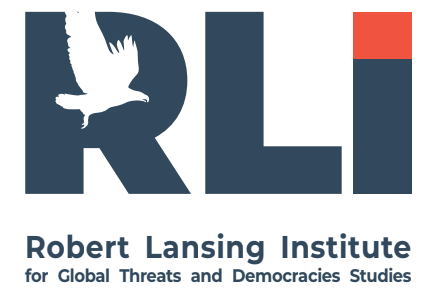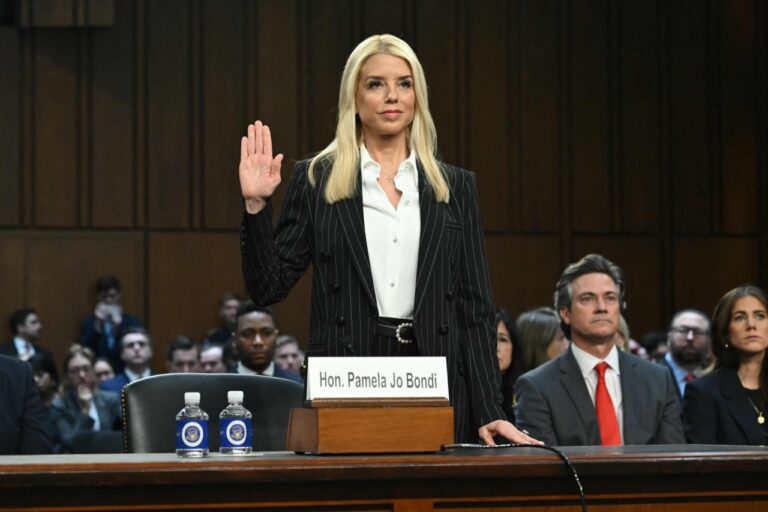Russia is actively using the Russian Orthodox Church (ROC) to influence the United States.: A group of Republican members of the U.S. House of Representatives has appealed to Attorney General Pam Bondi, urging an investigation into the use of Orthodox churches in the United States by Russian intelligence services. The initiative came from Congressman Joe Wilson. The lawmakers believe that the Kremlin-controlled Russian Orthodox Church Outside Russia (ROCOR) “is actively seeking to expand its political influence” in the United States. Similar concerns are being raised regarding Moscow’s use of other Orthodox jurisdictions operating in the U.S.
Specifically, the concern relates to an event involving the arrival of priests from the Russian Orthodox Church in Washington for meetings with representatives of the White House Office of Faith-Based and Neighborhood Partnerships, State Department officials, and congressional lobbyists.
The congressmen behind the letter warn that clergy and lobbyists tied to the ROC may serve as instruments of foreign influence or even intelligence gathering. The legislators describe these actions as serious and state that there is “reasonable suspicion” of such operations being carried out.
The Russian Orthodox Church is not merely a religious institution, but an instrument of the Kremlin’s foreign influence, used to advance the ideology of the “Russian World” and to destabilize the spiritual environment in countries where its structures are active. The ROC has openly cooperated with Russian intelligence services for decades. In Ukraine, the Ukrainian Orthodox Church (UOC), which is part of the ROC, facilitates the establishment of occupation rule in territories seized by Russia.
In the United States, both the ROC and ROCOR are active. The formally autocephalous Orthodox Church in America (OCA) — which received its status from the ROC (and is therefore not recognized as autocephalous by most other Orthodox churches) — continues to maintain close ties with Moscow. Russia also wields influence in the U.S. through several national autocephalous churches traditionally aligned with Moscow whose structures operate in America (Serbian, Bulgarian, etc.).
The use of religious communities is a classic hybrid tactic of the Kremlin. Through church networks, Russia and its intelligence services seek access to elites, politicians, and the media, building influence under the guise of “spiritual dialogue” and the defense of “traditional values and Christianity.” To support this activity, Moscow provides its affiliated religious structures abroad (including in the U.S.) with financial and informational resources, using them to promote pro-Russian propaganda in the West. The lobbying events on Capitol Hill mentioned in the congressmen’s letter are a clear example of this use of religious infrastructure and institutions.
Confirmation of the lawmakers’ suspicions would mean that organizations operating on U.S. soil function not only as religious bodies, but as networks of influence for the Russian Federation, a state that openly positions itself as an adversary of the United States.
• Structures of the ROC and other affiliated churches in the United States may act as instruments of Russian intelligence, granting the Kremlin access to U.S. political institutions and public life. Religious communities are used to promote pro-Russian propaganda, particularly through messaging around “traditional values” and Christian identity.
• Religious networks controlled by the Kremlin may influence U.S. lawmakers and officials, shaping their attitudes toward Russia, cultivating an uncritical view of Moscow, and altering their overall approach to foreign policy.
• Through church structures, Russia seeks to shape a negative image of Ukraine, portraying it as a country that allegedly “persecutes Orthodox Christians.” The Kremlin’s goal is to undermine diplomatic and military support for Kyiv — a direct challenge to U.S. geopolitical interests.
• Attempts by the Russian Church to influence U.S. political realities may undermine American sovereignty in the informational and ideological domain. They may also create reputational risks: revelations of ties between segments of the American Orthodox community and Russia could provoke internal political conflict.
• The subversive activity of the ROC in support of the Kremlin and Russian intelligence services on U.S. territory is not new. The ROC abroad has long harbored political ambitions; within Russia, the Church has effectively become part of the state’s ideological apparatus, and it has played an active role in Russian foreign policy for many years.
How the ROC Operates as an Intelligence-Cover Network
- Clergy as “covered personnel” – priests with diplomatic immunity or semi-diplomatic status can travel freely, meet officials, and are rarely scrutinized.
- Use of confession, pastoral counseling, and charitable networks as non-transparent channels to gather sensitive personal and political information.
- ROC as an FSB/SVR logistics platform – Moscow Patriarchate’s Department for External Church Relations (DECR) has a long history of working closely with Russian intelligence.
- Church-linked NGOs serving as influence operations hubs (e.g., foundations promoting “traditional values” often overlap with FSB/SVR networks).
historical background on ROC intelligence cooperation
- Soviet-era KGB infiltration of the Russian Orthodox Church (documented in archives opened in the 1990s).
- How senior ROC hierarchs carried KGB code-names (“Agent DROZDOV”, “Agent ADAMANT”).
- The role of the ROC in Soviet foreign policy, especially in:
- Peace Movement fronts,
- World Council of Churches,
- Ecumenical assemblies where Soviet agents traveled freely.
- Continuity into modern Russia — FSB/SVR officers embedded in DECR and Orthodox missionary structures abroad.
This historical continuity reinforces the argument that current activity is part of a long-standing pattern, not a new phenomenon.
3 U.S. vulnerabilities that the Kremlin exploits
Highlight:
- American society’s high tolerance for religious lobbying.
- Legal protection under the First Amendment and reluctance to scrutinize religious institutions.
- Lack of Foreign Agent Registration Act (FARA) enforcement regarding religious groups.
- U.S. politicians’ cultural appeal toward “traditional Christian values,” which Moscow weaponizes.
This turns a descriptive paper into a policy-relevant analysis.
The hierarchy of ROC structures operating in the U.S.
- Moscow Patriarchate parishes (direct ROC presence).
- ROCOR (nominally autonomous but subordinated to Moscow since 2007).
- The Orthodox Church in America (OCA) — de facto aligned due to its Russian-granted autocephaly.
- Serbian, Bulgarian, and other Slavic Orthodox jurisdictions that traditionally coordinate with Moscow.
- Russian-funded Orthodox cultural centers, schools, monasteries.
This helps show depth and density of the Russian religious network.
The influence methods used in Washington
Examples:
- Closed-door meetings between ROC clergy and U.S. federal officials.
- Invitations to prayer breakfasts, interfaith dialogues, and congressional roundtables.
- Funding to U.S. lobbyists under religious cover.
- Attempts to shape discussions on:
- “Traditional values,”
- “Defense of Christians in Eastern Europe,”
- “Persecuted Orthodox believers,”
- Anti-LGBT legislation,
- Opposition to U.S. sanctions.
This reveals operational techniques, not just broad claims.
Case studies
- A summary of the recent Republican congressmen’s letter as a case of U.S. alarm.
- ROC lobbying attempts in the U.S. Congress in 2023–2024.
- Examples of ROC-linked individuals who were previously expelled, sanctioned, or suspected of foreign-agent activity.
- Cases of ROC influence in Europe (France, Moldova, Serbia) to show the global pattern and how the U.S. fits into it.
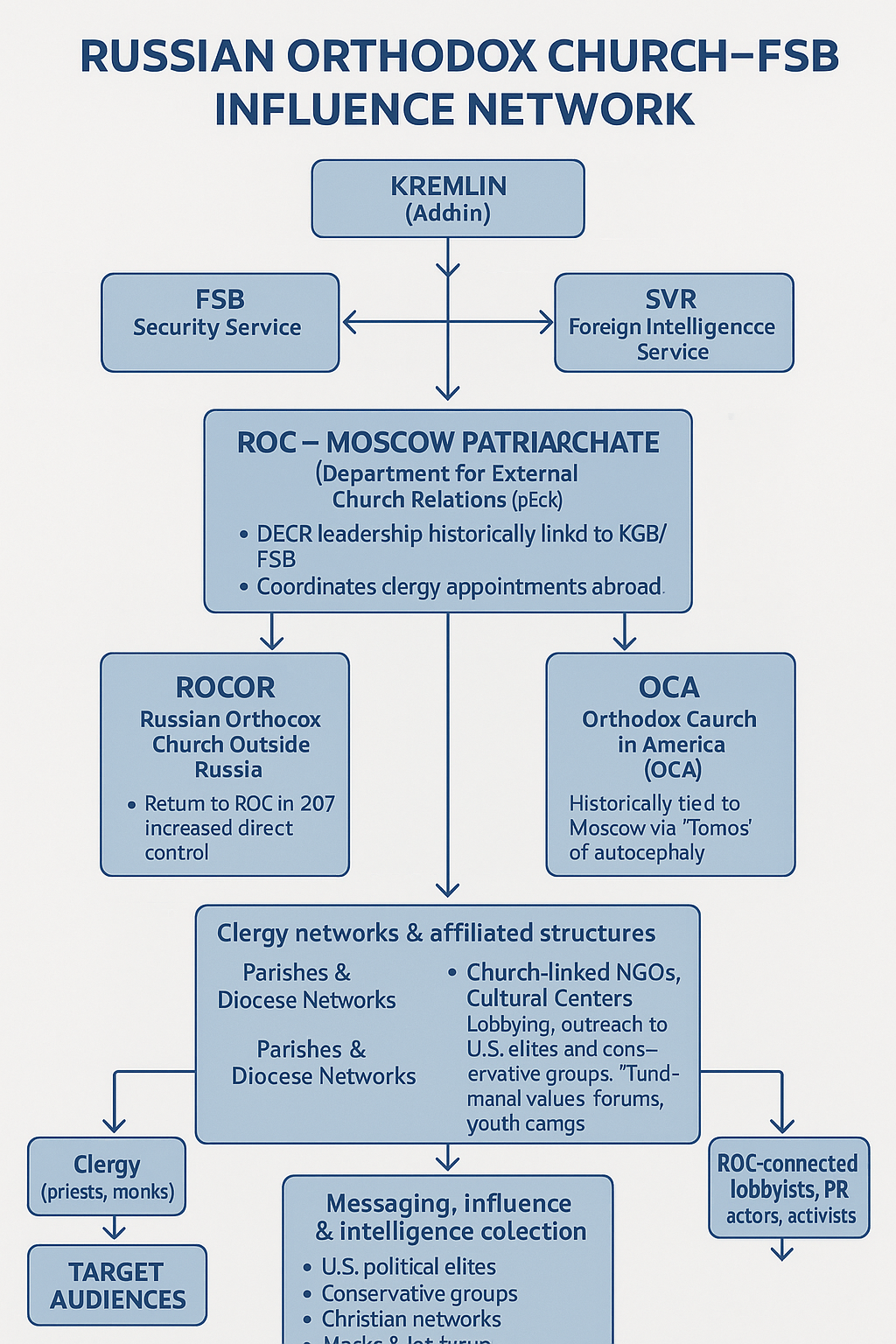
7 Kremlin narratives amplified through ROC platforms
The Kremlin themes spread through Orthodox structures in the U.S.:
- “Russia protects Christianity.”
- “Ukraine persecutes Orthodox believers.”
- “Western liberalism destroys family values.”
- “Sanctions against Russia are anti-Christian.”
- “America needs an alliance of traditional civilizations.”
Showing these ideological vectors strengthens analytical depth.
Holicy recommendations for U.S. institutions
Recommendations include:
- Expanding FARA requirements to religious organizations with foreign leadership.
- Mandatory transparency of financial flows to ROC-linked entities.
- Counterintelligence monitoring of church-affiliated foundations.
- Training for federal agencies on religious-influence tradecraft.
- Creating a federal registry of foreign-funded religious structures.
- Coordination between FBI, DHS, and State Department on ROC-linked operations.
A geopolitical context section
- Russia is trying to weaken U.S. bipartisan support for Ukraine.
- Kremlin networks are seeking to penetrate conservative circles and Christian organizations sympathetic to “traditional values.”
- ROC messaging aligns with Russia’s disinformation and culture-war strategies.
- Moscow aims to undermine American unity, fragment political coalitions, and create soft sympathy for Russia among religious voters.
This section links ROC activities to broader Russian strategy.
U.S.-Based Clergy, Lobbyists, and Influence Figures
| Name / Role | Affiliation | Activity in U.S. | Connection to Russian State / ROC |
|---|---|---|---|
| Priests traveling from Moscow for “interfaith dialogue” | ROC / DECR | Meetings with White House Office of Faith-Based Initiatives; State Dept. contacts | Considered by U.S. lawmakers as potential intelligence conduits |
| ROCOR parish priests (various) | ROCOR | Pastoral access to conservative, Slavic-American communities; political messaging | ROCOR hierarchy subordinate to Moscow since 2007 |
| Orthodox Church in America (OCA) clergy with pro-Moscow alignment | OCA | Participation in panels on Ukraine/“persecution of Christians”; indirect lobbying | OCA’s autocephaly granted by Moscow; ongoing theological/organizational ties |
| Pro-Russian Orthodox activists in U.S. conservative circles | Independent / church-linked NGOs | Promotion of “traditional values,” anti-LGBT campaigns, anti-Ukraine narratives | Often funded by Russian donors or ROC-associated foundations |
| Russian diaspora cultural associations (church-adjacent) | Various | Organizing events with ROC clergy, amplifying Kremlin narratives | Networks overlap with Russian embassy and consulate contacts |
| ROC-connected lobbyists on Capitol Hill | Faith-based lobbying firms | Arrange meetings with lawmakers; frame Russia as “defender of Christianity” | Identified in congressmen’s complaint as potential foreign agents |
Timeline of ROC Operations in the United States (Cold War → 1990s → 2022–2025)
Cold War Era (1945–1991): Foundations of the Influence Network
Late 1940s–1950s
- Soviet intelligence begins using ROC clergy abroad as cover.
ROC representatives in the U.S. travel extensively for “ecclesiastical diplomacy,” often overlapping with KGB officers under religious cover.
1960s–1970s
- KGB infiltration of ROC foreign structures becomes systematic.
The Council for Religious Affairs (CRA) and the KGB’s First Directorate coordinate ROC activities abroad, including in the U.S. - ROC clergy join delegations to the World Council of Churches, giving Moscow indirect access to U.S. Protestant and Catholic networks.
1980s
- ROC priests in the U.S. engage in:
- Cold War “peace movement” activities,
- anti-nuclear messaging aligned with Soviet propaganda,
- outreach to American Christian leaders sympathetic to détente.
Post-Soviet Period (1991–1999): Restructuring & Repositioning
Early 1990s
- ROC maintains a modest but ideologically aligned presence in the U.S.
ROCOR (Russian Orthodox Church Outside Russia), originally anti-Soviet, remains institutionally separate.
Mid–late 1990s
- Moscow Patriarchate begins quiet rapprochement with ROCOR.
- U.S.-based ROC networks support:
- Russian émigré consolidation,
- cultural influence efforts,
- expat community mobilization under “defender of Orthodoxy” themes.
2000–2010: Putin Era Consolidation & ROCOR Absorption
2000–2007
- Putin’s administration uses the ROC as a foreign-policy instrument.
- Moscow intensifies contacts with:
- OCA (Orthodox Church in America),
- ROCOR hierarchs,
- U.S. Orthodox seminaries and cultural institutions.
2007
- Historic reunification: ROCOR signs the Act of Canonical Communion with the Moscow Patriarchate.
➤ This places ROCOR’s U.S. dioceses directly under Moscow’s ideological and administrative influence. - ROCOR clergy begin participating in Moscow-approved “Russian World” narratives.
Late 2000s
- ROC-sponsored cultural forums, Slavic heritage events, and “traditional values” conferences proliferate across the U.S.
2010–2021: Expansion of Political Influence & Conservative Alignment
2010–2014
- ROC-affiliated organizations deepen relationships with U.S. conservative groups via:
- anti-LGBT platforms,
- “defense of Christian values” messaging,
- interfaith dialogues designed to build political capital.
2014–2016
- After Russia’s annexation of Crimea, ROC structures help promote:
- narratives about “persecuted Orthodox Ukrainians,”
- pro-Kremlin interpretations of the conflict.
2016–2020
- ROC clergy participate in U.S. events linked to:
- Faith-based diplomacy,
- National Prayer Breakfast circles,
- lobbying networks adjacent to political campaigns.
2022–2025: Full-Scale Influence Operations Under Wartime Conditions
2022 (After Russia’s invasion of Ukraine)
- ROC and ROCOR pivot to aggressive lobbying and narrative warfare in the U.S.:
- Justifying Russia’s invasion through religious rhetoric,
- Promoting “traditional Christian civilization vs. liberal West” frames,
- Disseminating disinformation about Ukraine “persecuting Orthodox believers.”
- Multiple ROC priests travel from Moscow to Washington for “dialogue” meetings with:
- State Department officials,
- White House faith-office representatives,
- congressional staff.
2023
- Congressional concern escalates.
Intelligence-linked analysts and lawmakers warn that ROC clergy could be acting as:- influence agents,
- information collectors,
- mediators for Kremlin narratives in conservative circles.
- ROCOR parishes in the U.S. expand “humanitarian fundraising,” some of which is suspected of supporting Russian military-linked charities or propaganda channels.
2024
- U.S.-based ROC/ROCOR networks increase involvement in:
- anti-Ukraine activism,
- campaigns portraying Russia as a defender of Christianity,
- cultural diplomacy targeting conservative Christian groups.
- The ROC engages more openly in lobbying on Capitol Hill, using:
- ethnic community groups,
- religious NGOs,
- politically connected intermediaries.
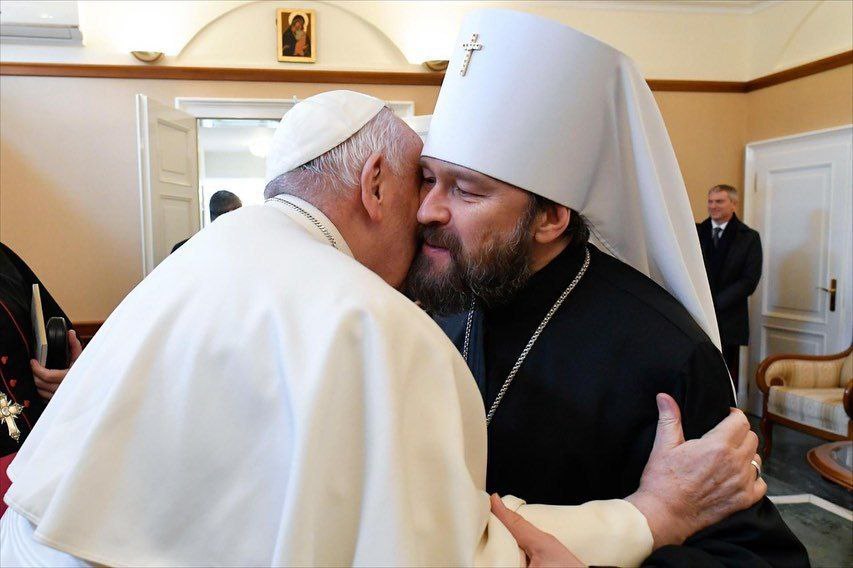

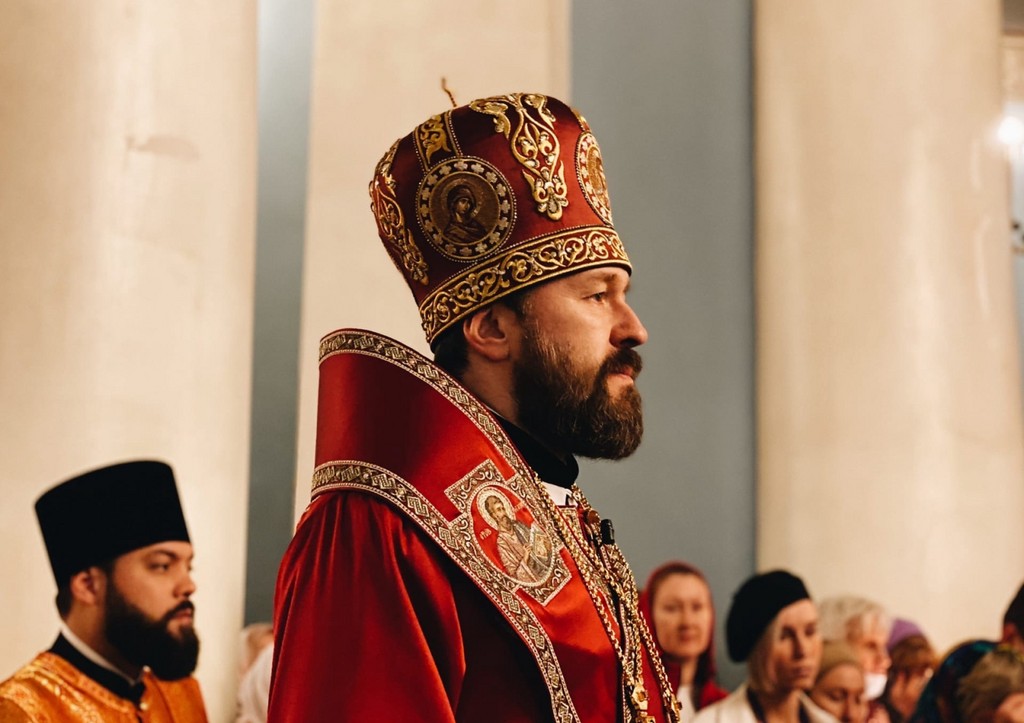
More on this story: Church: lobbying channels for Russia
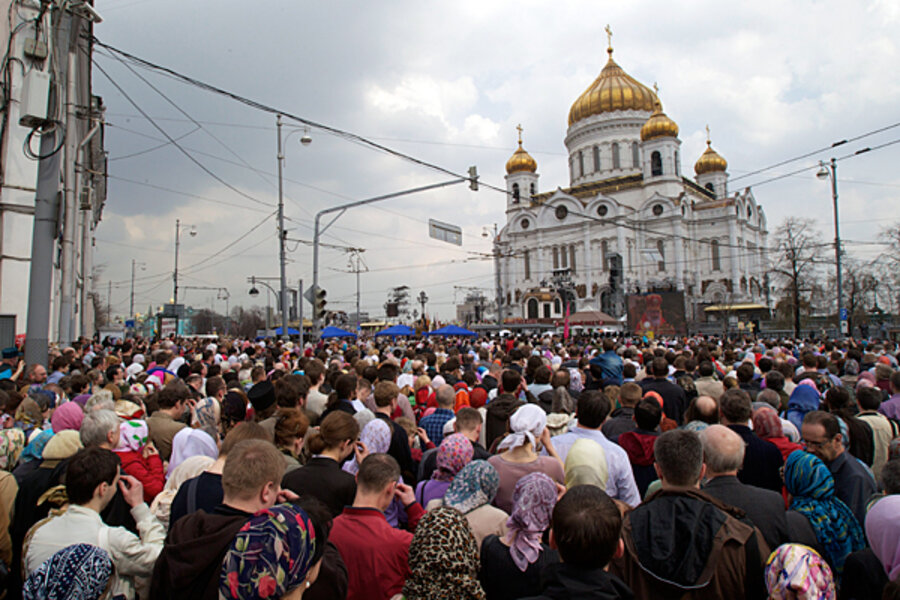
More on this story: Modern Russia. Role of the Orthodox Church in the State
| # | ROC Activity in the U.S. | Description / Typical Behavior | Linked Russian Doctrine | How It Fits the Doctrine |
|---|---|---|---|---|
| 1 | Lobbying on Capitol Hill via clergy & “faith NGOs” | ROC/ROCOR priests and associated lobbyists meet with members of Congress, staffers, and faith offices to discuss “traditional values,” “Christian persecution,” sanctions, Ukraine, etc. | Active measures | Covertly shapes U.S. policy debates and elite perceptions while masquerading as purely religious advocacy; creates pressure points against sanctions and support for Ukraine. |
| 2 | Narrative: “Ukraine persecutes Orthodox Christians” | Sermons, talks, and media interventions portraying Kyiv as oppressing canonical Orthodoxy and violating religious freedoms. | Active measures / Disinformation | Classic Kremlin narrative operation: discredit Ukraine, weaken Western support, and recast Russia as a protector of faith; uses religious language to launder geopolitical messaging. |
| 3 | Promotion of “traditional values” & anti-LGBT agenda | Conferences, parish lectures, joint events with U.S. conservative groups emphasizing “family values,” opposition to “gender ideology,” etc. | Soft influence / Cultural warfare | Builds ideological affinity between Russian state-church line and parts of the U.S. right; creates a pro-Russian constituency that sees Moscow as an ally in the culture war. |
| 4 | High-level meetings with White House, State Dept., faith offices | Delegations of ROC clergy from Moscow to Washington under the label of interfaith or “peace” initiatives. | Spiritual diplomacy / Intelligence cover | Provides semi-official channels for conveying Kremlin positions, probing U.S. officials, and collecting atmospherics under a low-scrutiny religious umbrella. |
| 5 | ROCOR & OCA parish networks among Russian/Slavic diaspora | Parishes serve as community hubs for Russian-speaking migrants, veterans, businesspeople, and students. | Soft influence / Human intelligence base | Long-term cultivation and spotting of potential assets; shaping diaspora attitudes to align with Kremlin narratives; early warning on politically active émigrés. |
| 6 | Church-linked cultural centers & “Russian World” events | Festivals, lectures, language schools, and history talks hosted by parishes or partnered NGOs. | Spiritual diplomacy / Soft power | Normalizes the “Russian World” concept, legitimizes Moscow’s worldview, and embeds Russian state narratives inside religious and cultural activities. |
| 7 | Humanitarian & “charity” fundraising for Donbas / “victims” | Collections in U.S. parishes or online drives ostensibly for humanitarian relief in Russian-controlled territories. | Active measures / Material support | Potential channel for financial support to pro-Russian structures; creates moral justification for Russian actions and portrays them as humanitarian. |
| 8 | Use of confession, pastoral counseling, and private meetings | Clergy maintain privileged, confidential access to believers, including officials, ex-military, and community leaders. | Intelligence support / Access operations | Offers opportunities to gather sensitive personal and political information that can be exploited by Russian services; ideal for soft blackmail or recruitment spotting. |
| 9 | Joint forums with U.S. think tanks, universities, or advocacy groups | ROC-linked speakers on panels about religious freedom, “civilizational dialogue,” or Eurasian security. | Active measures / Elite capture | Inserts Kremlin framings into expert discourse, blurs lines between legitimate scholarship and propaganda, and recruits “useful experts” who echo Moscow’s line. |
| 10 | Media presence in Orthodox and conservative outlets | ROC/ROCOR clergy give interviews, op-eds, podcasts targeting U.S. religious audiences. | Disinformation / Soft influence | Repeats Kremlin narratives through trusted religious voices; lowers resistance among audiences who distrust mainstream media but trust clergy. |
| 11 | Coordination with Russian embassies/consulates | Participation of clergy in official events; embassy support for church projects. | Spiritual diplomacy / Integrated state-church ops | Synchronizes church messaging with official Russian diplomacy; ROC acts as a parallel foreign-policy channel that can reach circles diplomats cannot. |
| 12 | Networked ties with Serbian, Bulgarian, and other pro-Moscow churches | Joint liturgies, conferences, and lobbying with other Slavic Orthodox jurisdictions in the U.S. | Coalition-building in active measures | Broadens the perceived legitimacy of pro-Russian narratives by presenting them as a “pan-Orthodox” position, not just a Russian one. |
2025
- Republican members of Congress publicly call for investigation into ROC and ROCOR activities as potential vehicles for Russian intelligence operations.
- Concerns focus on:
- direct coordination with Moscow,
- ideological penetration,
- recruitment of sympathetic U.S. political actors,
- covert influence operations under religious cover.
